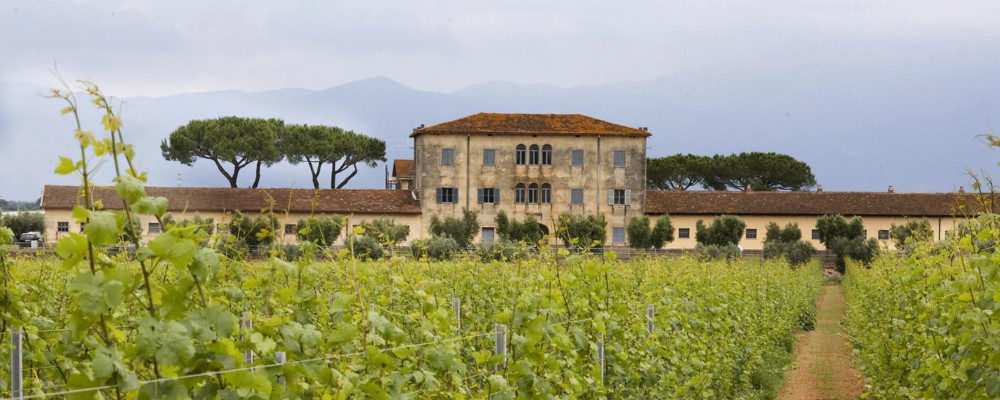Before the summer holidays season slowed things down, I attended a dinner featuring the wines of Casale del Giglio, a half-century old winery outside of Rome near the coastal town of Anzio. Elise Rialland and Giovanni Silvestri from Casale del Giglio were in Toronto for the 2022 edition of the Tre Bicchieri wine show, which had not been staged since 2019. They and Giglio’s Ontario importer, Profile Wine Group—represented by sommelier Drew Walker—hosted the dinner of typical Roman food at Enoteca Social.
Casale del Giglio is an interesting winery because they are both very much on trend and very much against it. It was begun in the 1960’s by a Roman wine merchant, Dino Santarelli. His son, Antonio Santarelli, began an intensive planting project in the 1980’s to probe the potential of their coastal part of the region of Lazio, with the cooperation of several of the viticultural colleges across Italy. As was the fashion then, though frowned upon in some circles now, they planted a number of “international” varieties of grapes.1“International” grapes are grapes native to France, like Cabernet Sauvignon or Chardonnay, when they’re grown outside of France. But they also planted indigenous ones like Bellone and Cesanese, which are in fashion now.
Over many courses, served family style, of Roman specialties like supplì, cacio e pepe, carbonara and Amatriciana we tasted through two of Casale del Giglio’s “international” wines and two of their indigenous grape-made wines. All of the wines were designated as simply “Lazio IGT”.
First of the internationals was the 2021 Viognier, which paired particularly well with Chef Kyle Rindinella’s house-made mortadella. When Viogner is made well, as this one was, it has the best of both worlds character of being weighty on the palate with peachy fruit and aromatic on the nose with white flowers. In any event, the wine worked particularly well as an aperitivo, being interesting enough to hold it’s own between nibbles of salumi and olives.
The second international wine we tried was the last of the meal: the 2017 Mater Matuta, Casale del Giglio’s flagship red. Named for the goddess of the dawn, the Mater Matuta is 85 percent Syrah rounded out with 15 percent Petit Verdot. It showed intense and inky black fruit finished with Mediterranean scrub, haloed by the aroma of violets.
Both wines drank as proof that fruit from all those French vines planted 40 or 30 years ago is really coming on line as the plants mature and yield diminishes in favour of concentration of flavour. Purists who, following the dogma of the cult of authenticity, eschew wines made from French grape varieties outside of France, don’t know what they’re missing.
After the Viogner, as the Pecorino cheese-based Roman pasta dishes began to come out, we tried the 2021 Bellone. Bellone is a white wine grape known to be native to the Lazio (or Latium) coast since at least ancient Roman times, as it was cited in Pliny the Elder’s natural histories.
The hills around Anzio are subject to a near constant breeze from the Tyrrhenian Sea, and past the Casale del Giglio Bellone’s big stone and citrus fruit notes is a salinity. Combined with a racy acidity, that briny character evokes that elusive food-friendly and moreish characteristic known as minerality. Paired with cacio e pepe (literally, pasta with cheese and pepper), I was transported back to the sunny terrace of Flavio al Velavevodetto in Testaccio.
After the Bellone we made the switch to red and tried the 2020 Cesanese. Casale del Giglio has very much been a part of the Risorgimento of the ubiquitous, if formerly under-appreciated, grape of Lazio. Cesanese has found a pride of place on 21st-century Roman wine lists.
The winemaker at Casale del Giglio is Paolo Tiefenthaler, who hails from the Alpine Trentino-Alto Adige region in Italy’s Northeast. It may have been my imagination, fuelled by the power of suggestion, but the 2020 Casale del Giglio Cesanese had an element of white pepper and a gentleness of red cherry fruit that reminded me of the reds found there, like Lagrein and Schiava.
Structured by silky tannins produced by a long maceration on its skins, the Cesanese wanted food and went perfectly with its classic pairing of Amatriciana, giving contrast to the salty cured guanciale and harmonizing with the tomato and garlic. This time the wine glass time machine took me to dinner near the Trevi Fountain and the 1920’s wood-panelled elegance of the great Trattoria al Moro.2“A stone’s throw from the Trevi Fountain, it frees all the flavours of authentic Roman cuisine. A local restaurant with outdoor seating, where you can taste dishes prepared with the authenticity of fresh and local ingredients. Cheeses and cold cuts of our own production, fresh pasta dishes and homemade desserts, Trattoria al Moro is an ideal place for those who want a real Roman dinner, surrounded by the historical beauty of the capital.” https://ristorantealmororoma.it/en/
Given that Rome attracts so many tourists (and pilgrims!), it seems curious that its wines are not more widely known. One explanation could be that the Romans, and their visiting guests, drink most of what’s made, so not that much is put aside for export. If you have eaten well in Rome, it’s very likely you have drunk Bellone and Cesanese, and it’s entirely possible they were made by Casale del Giglio.
There is a point in all wine tasting dinners when someone (often me) needs to raise the vulgar subject of commerce and ask how much the wines being tried cost. Drew Walker explained that the Viognier and Mater Matuta were not currently in the market, but might be priced in Canada at around $25-$30 and $65-70, respectively, when they were.
The Bellone and the Cesanese, however, are or will be soon in the market and cost roughly $22 and $25 per bottle. I commented that I thought this was good value for well-made wines and asked if they were due to be sold at the Liquor Control Board of Ontario,3“The Liquor Control Board of Ontario (LCBO) is a government enterprise and a responsible retailer and wholesaler of wine, beer, and spirits in Ontario.” https://www.lcbo.com/content/lcbo/en/corporate-pages/about-LCBO.html where I had seen them (and bought them) in the years before. They would not, I was told, but could be ordered online by the case from Profile Wine Group.
I am glad the wines are available, but the removal of the two wines from regular retail availability worries me. The wine trade is most profitable at its lowest and highest ends. The most money is made from selling bulk, or factory made wines at high volume for a low price (let’s say around $10 a bottle). And the biggest margins can be made by selling luxury wines for a high price (let’s say over $30 a bottle), mostly to restaurants, who view wine purchases as a business expense and an investment.
The individual wine enthusiast will treat themselves to luxury wines at whatever frequency they can afford, but most of us would like access to well-made wines at an approachable price that we can pour with some regularity. The good news is that the world is full of producers making lovely wines that fit into the $15 to $30 price range. It would be a shame if big retailers, especially ones that operate on a government backed near monopoly, got in the way between trade between the two.
More on this, and the danger of a “missing middle” in the wine world, to come…




